
The IRA Uncovered: A Deep Dive Into Its Origins, Advantages, and Pitfalls
In a financial world grappling with volatility, taxation, and longevity risk, the Individual Retirement Account (IRA) remains a pillar of American retirement planning—yet few truly understand its evolution, strategic potential, or hidden drawbacks. With trillions of dollars now parked in these accounts, the stakes are high for both policymakers and investors. This isn’t just a tax-sheltered bucket—it’s a complex, powerful tool that deserves a closer, smarter look.
The Birth of the IRA: A Legislative Response to a Shifting Economy
The IRA was born in 1974 under the Employee Retirement Income Security Act (ERISA), a sweeping piece of legislation designed to secure worker pensions in an era of economic instability. Initially modest in scope—capped at $1,500 in contributions and available only to those without employer-sponsored plans—it was a legislative footnote that would soon gain momentum.
The 1981 Economic Recovery Tax Act democratized the IRA, making it available to nearly all working Americans. Contributions soared. By 1997, the Roth IRA emerged, offering a tax-free growth model—revolutionary at a time when the tech boom was minting young investors looking for long-term upside.
Today, IRAs hold over $12 trillion in assets, according to the Investment Company Institute. Their evolution reflects a broader shift: from employer-centric pensions to individually-managed retirement solutions.
The Advantages of IRAs: Tax Strategy, Flexibility, and Compound Power
1. Tax Deferral and Tax-Free Growth
Traditional IRAs offer upfront tax deductions, lowering current taxable income. Roth IRAs flip the equation: no deduction today, but tax-free withdrawals in retirement. Both options leverage the power of tax-advantaged compounding—a mathematical edge that significantly widens the gap over taxable accounts over decades.
2. Investment Flexibility
Unlike many 401(k) plans limited to a menu of mutual funds, IRAs often grant access to a broader range of assets: ETFs, stocks, bonds, even real estate via self-directed IRAs. That breadth can be a powerful advantage for sophisticated investors seeking precision.
3. Estate Planning Opportunities
Certain IRA structures allow beneficiaries to stretch distributions over their lifetime (although recent SECURE Act changes have tightened these rules). Roth IRAs, in particular, are a strategic legacy vehicle—tax-free and with no required minimum distributions (RMDs) during the original account holder’s life.
The Drawbacks: Complexity, Risk, and Regulatory Shifts
1. Contribution Limits and Phase-Outs
With a $7,000 cap in 2024 ($8,000 for those 50 and older), IRA contributions remain modest relative to income potential. Roth IRAs impose income thresholds, excluding high earners—though workarounds like the "backdoor Roth" exist, they add legal and logistical complexity.
2. Early Withdrawal Penalties
Accessing funds before age 59½ can trigger a 10% penalty plus taxes (with some exceptions). For savers looking for flexibility or liquidity, this restriction can be a strategic liability.
3. Legislative Risk
The IRA is a political creature. The SECURE Act of 2019 and SECURE 2.0 Act of 2022 dramatically reshaped RMD timelines and withdrawal strategies. Future reforms could introduce new taxes, limits, or restrictions—especially as Washington eyes untapped tax revenue in a fiscally strained era.
4. Mismanagement Risk
IRAs offer freedom—but also responsibility. Poor asset selection, misjudged risk, or improper beneficiary designations can erode value or create tax headaches. Unlike 401(k)s, which often benefit from institutional oversight, IRAs place the onus on the individual.
Case Study: The Power—and Peril—of Roth Conversion
Take the example of a 45-year-old executive with a $500,000 traditional IRA and a high marginal tax rate. Converting to a Roth IRA today would trigger a substantial tax bill, yet it could shield future gains from taxation entirely. If markets surge or tax rates climb, the long-term payoff can be enormous. But if assumptions about future income or returns are wrong, the move can backfire.
This balancing act—between short-term cost and long-term reward—is emblematic of the broader IRA strategy landscape. There are no one-size-fits-all solutions. Only trade-offs.
The Future of the IRA: Evolving With the Retirement Crisis
As Americans live longer and defined benefit pensions fade into history, IRAs are no longer a supplement—they are often the core. Policymakers have taken notice. Secure 2.0 has already pushed RMD ages later (to 73 and eventually 75), boosted catch-up contributions, and encouraged automatic enrollment features. Expect more.
Meanwhile, wealth managers are designing tax-layered portfolios that optimize across IRAs, Roths, 401(k)s, and taxable accounts—what some call "tax diversification." This next-gen approach reflects a deeper truth: the IRA is no longer just a tax shelter. It’s a strategic chess piece in an increasingly complex retirement landscape.
Conclusion: Don’t Just Open an IRA—Understand It
The IRA has traveled a long arc from its 1970s origins. It is now a central character in the retirement drama, carrying enormous tax implications, investment flexibility, and planning complexity. Used wisely, it’s one of the most powerful vehicles available to individual investors. Misused—or misunderstood—it can be a source of frustration and lost opportunity.
The key is not to treat the IRA as a product, but as a strategy. And that requires what every great strategy demands: foresight, data, and disciplined execution.

